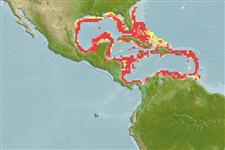>
Perciformes/Scorpaenoidei (Scorpionfishes) >
Scorpaenidae (Scorpionfishes or rockfishes) > Scorpaeninae
Eponymy: In Roman mythology, Castor and his brother Pollux were the heavenly twins. However, in Latin Castor also means ‘beaver’, and the mormyrid was so named because of the teeth which protrude from its lower jaw, like a beaver’s incisors. (Ref. 128868), visit book page.
More on author: Poey.
Environment: milieu / climate zone / depth range / distribution range
Ecologia
marino demersale; distribuzione batimetrica 45 - 400 m. Tropical; 32°N - 9°N, 98°W - 60°W
Western Atlantic: Bermuda and southeastern Florida, USA to Colombia.
Size / Peso / Age
Maturity: Lm ? range ? - ? cm
Max length : 46.0 cm TL maschio/sesso non determinato; (Ref. 26340); common length : 30.0 cm TL maschio/sesso non determinato; (Ref. 5217)
Inhabits hard bottom.
Life cycle and mating behavior
Maturità | Riproduzione | Deposizione | Uova | Fecundity | Larve
Robins, C.R. and G.C. Ray, 1986. A field guide to Atlantic coast fishes of North America. Houghton Mifflin Company, Boston, U.S.A. 354 p. (Ref. 7251)
IUCN Red List Status (Ref. 130435: Version 2024-1)
Threat to humans
Venomous
Human uses
Pesca: scarso interesse commerciale
Strumenti
Special reports
Download XML
Fonti Internet
Estimates based on models
Preferred temperature (Ref.
123201): 16.7 - 25.4, mean 21.2 °C (based on 59 cells).
Phylogenetic diversity index (Ref.
82804): PD
50 = 0.5000 [Uniqueness, from 0.5 = low to 2.0 = high].
Bayesian length-weight: a=0.01288 (0.00620 - 0.02676), b=3.03 (2.86 - 3.20), in cm total length, based on LWR estimates for this (Sub)family-body shape (Ref.
93245).
Trophic level (Ref.
69278): 3.5 ±0.37 se; based on food items.
Resilienza (Ref.
120179): Basso, tempo minimo di raddoppiamento della popolazione 4.5 - 14 anni (Preliminary K or Fecundity.).
Fishing Vulnerability (Ref.
59153): Moderate vulnerability (36 of 100).
